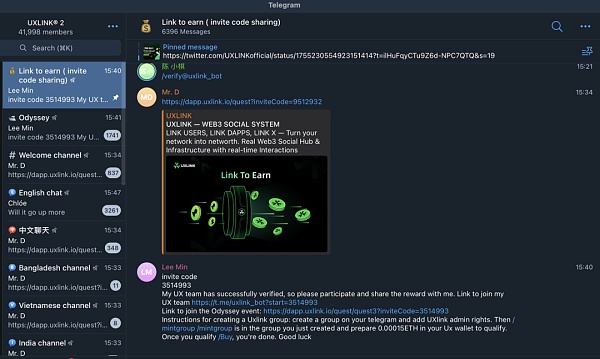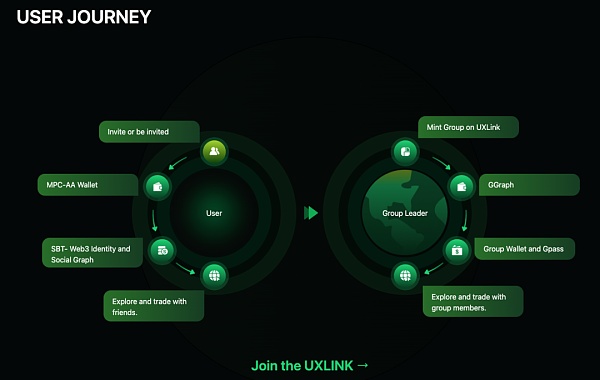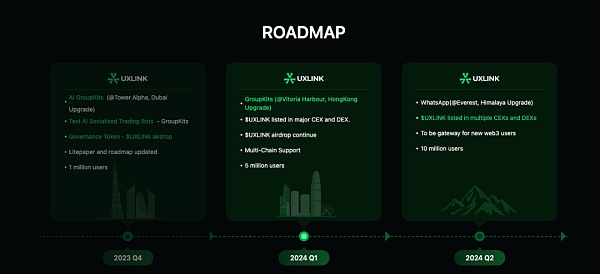If you want to ask which project in the Web3 social field has attracted the most attention recently, then it is the social monster UXLINK.
UXLINK builds a Web3 social platform based on acquaintance relationships by allowing users to quickly fission based on acquaintance social networks, and provides in-depth social scenarios and token incentives. Retain users and further grow, gaining a strong user base in a short period of time.
Since its launch in April 2023, UXLINK has had 3.4 million registered users and built more than 75,000 group chats. The number of users reached through group chats has reached 5.9 million people. This also confirms the UXLINK team’s deep understanding of Web3 social aspects.

(Source: https://www.uxlink.io/)
The key variable of current Web3 social networking: acquaintance social relationships
People cannot leave social relationships, With the development of information technology, social interaction and communication have been deeply digitized. From instant messaging to sharing life updates, people's social relationships have been deeply integrated into digital scenarios.
In the process of this social paradigm shift, we have witnessed the birth of killer applications such as Facebook and WeChat.
This is largely due to network effects: the value of a platform increases as the number of people using it increases. Especially in the social field, the network effect is particularly obvious, because people tend to gather on platforms where their friends and family are, which brings about the phenomenon of acquaintance fission, that is, after a user joins, his acquaintances also follow, thus quickly Expand user base.
Web3 is considered to be the next generation of the Internet, emphasizing features such as decentralization, blockchain technology and asset ownership, allowing users to truly own network assets and provide more Deep digital experiences.
Although the current users of Web3 are mainly concentrated in the fields of investment and speculation, as the technology matures and application scenarios expand, it is expected that there will be more mainstream users influx. Due to its powerful network effects, the social field is very likely to be the first to see the emergence of killer applications and platforms in the Web3 era.
There are currently several Web3 social platforms that have gained greater popularity, such as Lens Protocol, Farcaster and friend.tech.
Lens emphasizes social media data ownership and portability, allowing users to control their own data and move it freely between different applications; Farcaster emphasizes decentralization and user privacy , providing encrypted message transmission, allowing users to communicate freely without platform restrictions;
Friend.tech emphasizes social assetization and uses NFT for Users provide influence tokenization services. Although the above applications have made significant progress in innovation, the lack of emphasis on social networks of acquaintances in the early stages may have limited their rapid growth and retention.
In the era of Web1 and Web2, the greatest products are acquaintance social products such as email, facebook, and WeChat. In the same way, will the kings of Web3 also be acquaintance social products? ?
The core scenario of Web3 is transaction, and scenarios involving assets naturally require trust. Web2's social platform has completed relationship building and trust establishment.
Web3 social provides a further experience at the level of assets and ownership. Therefore, for Web3 social, it is built directly based on acquaintance relationships, which is the best choice for current Web3 users. The key to realizing Mass Adoption under the background of small base.
Products and Services: Growth, Retention and Ecology
The entire UXLINK system can be divided into three layers: Dapp layer, protocol layer, and infrastructure layer.
Dapp layer: user growth and precipitation
The Dapp layer provides users with core functions and services, including entrance, identity and group functions.
Entry layer: including MPC and account abstract wallet, providing users with seamless access to Web3 silk Sliding experience. After the user launches the app, the wallet based on the Arbitrum network will be automatically registered, and the existence of the private key and mnemonic phrase will be eliminated, improving the user's conversion rate.
Identity: including DID/Profile (SBT). Users can create Web3 accounts through social applications such as Telegram and WhatsApp, and obtain Web3 identities (DID) bound to off-chain identities; UXLink also uses zero-knowledge proof technology to help users build self-hosted identities (self-sovereign identities) , SSI) and private social relationships.
Group: Group is the core implementation scenario provided by UXLINK. Users can create group chats and perform fission based on social graphs to earn rewards; at the same time, users can own and share data (social relationship data). Users can use Mint group IDs to capitalize social relationship data and achieve true sustainability. have. In the future, AI assistant-related functions will also be provided to enable users to have a smoother social experience. Currently, UXLINK's groups are built in the form of Telegram plug-ins, which avoids reinventing the wheel, while allowing users to participate in projects through a familiar platform, eliminating switching costs for users.
The social "exchange", that is, the combination of DEX and groups, is not yet fully completed, but it already has swap The logic of primary functions such as Pinduoduo is similar to that of early Pinduoduo. Users can complete transactions during interaction, which not only enhances trust but also increases fun.
Growth application, that is, the LINK TO EARN engine, can obtain users and data for UXLINK, and can also serve third parties and help third-party Dapps grow.

In general, UXLINK's core functions at the three levels of portal, identity and group provide a complete tool for users to socialize. UXLINK uses Proof of Link (PoL) to encourage users to invite acquaintances and achieve growth. Coupled with the social functions that users are familiar with, as well as relationship building and relationship monetization, new users can obtain a friendly Web3 social experience at a very low threshold, ultimately supporting the Mass Adoption of Web3.

(Source: https://www.uxlink.io/)
Protocol layer: data monetization, ecosystem empowerment, and commercial closed-loop
The core of the protocol layer is data from the Dapp layer, mainly for Developer. The growth of UXLINK relies on the fission of users' acquaintance relationships, so the Dapp layer will accumulate a large amount of social relationship data. The value of acquaintance relationship data is self-evident. Platforms such as Pinduoduo and Linkedin are examples of utilizing acquaintance social relationships.
UXLINK provides Web3 developers with complete APIs, allowing developers to efficiently obtain user social relationship data from UXLINK, analyze it, and create actual business Value, this part of the revenue will be shared between users and UXLINK, allowing users to gain real value from their accumulated data and achieve a closed business loop.
Infrastructure layer: further building the ecosystem
UXLINK has an on-chain and off-chain hybrid scalable technology architecture (EVM + IPFS + Hubs) to support Mass Adoption application scenarios. It stores identity and relationship data on the chain (currently Arbitrum). Process complex business scenario data off-chain to support applications using the UXLINK Protocol. In addition, UXLINK can also provide services such as decentralized storage and centralized data indexing, mainly involving EVM chains (Ethereum Mainnet, Arbitrum L2 Chain, BNB Chain, Polygon and Base Chain, etc.).
In the future, with the further expansion of the user base and the development of ecological applications, UXLINK does not rule out the possibility of considering building its own social dedicated chain to further strengthen the synergy within the ecosystem. , opening up space for development.
The above is the product logic of UXLINK. The social track is different from other tracks. The application layer and the infrastructure layer have a symbiotic and mutually reinforcing relationship, which can produce Super applications can also become infrastructure for other tracks such as games and Defi.
Economic Model and Value Capture
UXLINK adopts a dual-token model, including the utility token $UXUY and the governance token $UXLINK.
Utility token $UXUY: mainly used to stimulate community growth and interaction of $UXUY.
Earn: Users can earn $UXUY by inviting friends and contributing to the ecosystem, and $UXUY will be stored in an EVM-compatible wallet , the earlier users enter, the more $UXUY they can get. As the user base of UXLINK grows, the rate at which users earn $UXUY will decrease exponentially, proposing the scarcity value of $UXUY. UXLINK calls this mechanism PoL (Proof of Link).
Destruction mechanism: $UXUY can be used to pay service fees (the cost of interaction within the ecosystem, UXLINK can also help users pay Commission with $UXUY). Of these fees, 3% - 15% will be destroyed, depending on the governance decisions of the UXLINK community.
Governance token $UXLINK: Mainly used to govern and capture the value generated by UXLINK products.
1. Supply: $UXLINK has a fixed supply of 1 billion pieces.
2. Release: $UXLINK will be released after being uploaded.
Community section: $UXLINK tokens will be airdropped to active users, builders and partners . It’s worth noting that once airdropped, there is no lock-in period, providing instant access.
Partner section: initially subject to a 3-month lock-in period, followed by a 2-year linear quarterly release. This means a gradual release of 12.5% each quarter for a total of 8 quarters, promoting long-term participation.
Team section: After a 6-month lock-up period, the team’s $UXLINK tokens will be released linearly quarterly for 2 years , releasing 12.5% each quarter for a total of 8 quarters, consistent with the long-term success of the project.
Treasury part: flexible release.
We can foresee that $UXUY will play an important role in ecological growth and fission, that is, allowing users to truly gain incentives, and also Allow new users to gain access to the core experience of Web3.
The existence of the destruction mechanism also enables $UXUY to maintain a relatively healthy circulation level after the number of users increases. $UXLINK will also capture value from the rapid growth of UXLINK.
(Source: https://docs.uxlink.io/uxuy-labs-api/whitepaper/white-paper)< /p>
Summary and Outlook
Mass Adoption is one of the core issues facing Web3 at the current stage. In the past few years, a large number of Social, low-threshold wallets, and DID projects have cleared the barriers for traditional users to enter Web3 at the scene and entrance levels.
With the recent SEC passing the BTC ETF, Web3 has once again entered the field of vision of a large number of traditional users. Applications that can allow traditional users to seamlessly enter and experience Web3 in depth will have It may land during this cycle. UXLINK captures the core variable of acquaintance socialization and uses acquaintance socialization as the underlying logic. At the same time, it takes advantage of the low-threshold infrastructure and the breakthrough of Web3. It will have great potential to succeed in this cycle.
From the Roadmap, we can truly see the team’s vision and confidence in Web3 Mass Adoption, and look forward to the subsequent performance of UXLINK.

(Source: https://www.uxlink.io/)
 JinseFinance
JinseFinance
 JinseFinance
JinseFinance JinseFinance
JinseFinance JinseFinance
JinseFinance JinseFinance
JinseFinance JinseFinance
JinseFinance JinseFinance
JinseFinance JinseFinance
JinseFinance JinseFinance
JinseFinance Nulltx
Nulltx Bitcoinist
Bitcoinist